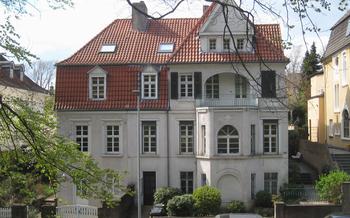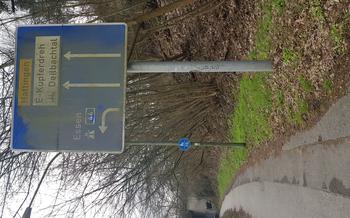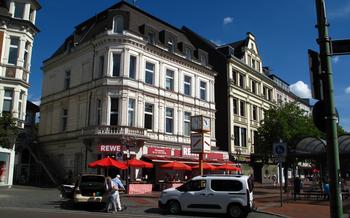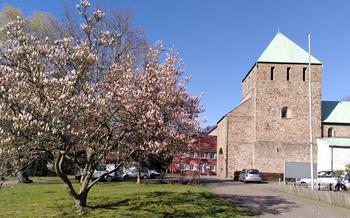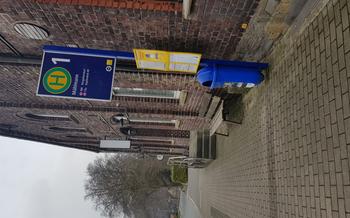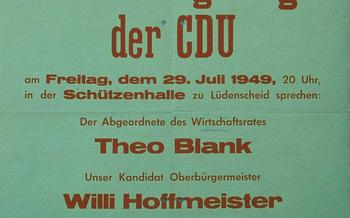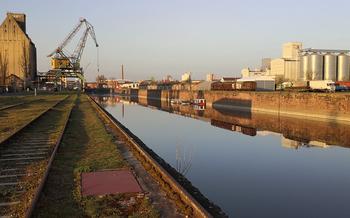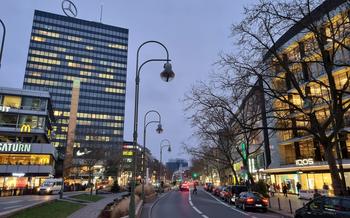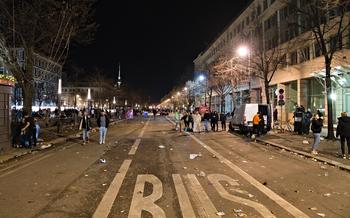
Schloss Borbeck
- Schloss Borbeck: A Historical Gem in Essen
- Exploring the Castle Grounds
- Uncovering the History of Schloss Borbeck
- The Castle's Architectural Highlights
- A Glimpse into the Castle's Interior
- The Castle's Haunting Legends
- The Surrounding Borbeck District
- Planning Your Visit to Schloss Borbeck
- Tips for Making the Most of Your Visit
- Schloss Borbeck for Outdoor Enthusiasts
- Events and Activities at Schloss Borbeck
- Schloss Borbeck's Role in the Community
- Schloss Borbeck's Contribution to Tourism
- Insider Tip: Hidden Gems in the Castle
Schloss Borbeck: A Historical Gem in Essen
Schloss Borbeck is a magnificent castle located in the heart of Essen, Germany. It stands as a testament to the city's rich history and architectural heritage. Built in the 14th century, the castle has undergone various transformations over the centuries, reflecting the changing tastes and influences of its successive owners. In its current form, Schloss Borbeck is a splendid blend of medieval, Renaissance, and Baroque architectural elements, showcasing its unique character and historical significance.
Today, Schloss Borbeck is not merely a historical relic but also a vibrant cultural venue and a beloved community landmark. It hosts an array of events throughout the year, including concerts, exhibitions, and festivals, attracting visitors from near and far. Whether you're a history buff, an architecture enthusiast, or simply seeking a peaceful escape, Schloss Borbeck offers an immersive and enriching experience that will leave you spellbound.
Exploring the Castle Grounds
Schloss Borbeck is surrounded by a vast and picturesque park that invites visitors to explore its natural beauty and historical charm. The park, designed in the English landscape style, features winding paths that lead through tranquil woods, past sparkling ponds, and over gentle hills. As you stroll through the grounds, you'll encounter notable landmarks that add to the castle's allure.
The eye-catching Orangery, a greenhouse built in the 18th century, stands as a testament to the castle's former grandeur. It once housed exotic plants and served as a gathering place for the castle's inhabitants. Today, it has been transformed into a charming café where visitors can relax and enjoy refreshments while soaking in the park's serene atmosphere.
Another highlight of the park is the Chinese Pavilion, a delightful folly built in the 19th century. Inspired by Chinese architecture, it features intricate carvings, colorful tiles, and a curved roof. It initially served as a garden folly but later became a popular spot for concerts and other cultural events.
In addition to its historical landmarks, the park offers a range of recreational activities for visitors of all ages. Whether you're looking for a leisurely walk, an invigorating jog, or a fun-filled cycling adventure, the park's extensive network of trails will cater to your needs. Designated picnic areas provide the perfect setting for a relaxing break amidst nature's beauty.
For those who want to delve deeper into the castle's history and its surroundings, guided tours are available. Knowledgeable guides will lead you through the park, sharing fascinating stories and anecdotes about the castle's past, its inhabitants, and the role it played in shaping the history of Essen.
Uncovering the History of Schloss Borbeck
The history of Schloss Borbeck is a rich tapestry of events that spans several centuries. Its origins can be traced back to the Middle Ages, when it was built as a moated castle by the Lords of Borbeck. Over the centuries, the castle changed hands several times, passing through the ownership of various noble families and ecclesiastical institutions.
During the Thirty Years' War (1618-1648), the castle was besieged and heavily damaged by Swedish troops. It was subsequently rebuilt in the Baroque style, incorporating elements of the Renaissance architecture that was popular at the time. In the 19th century, the castle underwent further renovations and expansions, resulting in the grand and imposing structure that we see today.
Tragically, Schloss Borbeck suffered significant damage during World War II, when it was hit by Allied bombs. The castle was left in ruins for many years, but thanks to extensive restoration efforts, it was eventually rebuilt and restored to its former glory. Today, Schloss Borbeck stands as a testament to the resilience and determination of the people of Essen, who were committed to preserving their cultural heritage.
The Castle's Architectural Highlights
Schloss Borbeck stands as a testament to the architectural prowess of its various builders over the centuries. Its defensive features, dating back to the Middle Ages, are evident in its sturdy walls, towers, and moats. These elements served to protect the castle from invaders and ensured its strategic importance in the region.
As the Renaissance period dawned, Schloss Borbeck underwent significant transformations, embracing the artistic and architectural ideals of the era. The addition of elegant windows, intricate carvings, and decorative elements imbued the castle with a sense of grandeur and refinement. The Renaissance influence is particularly noticeable in the castle's courtyard, where arcades and galleries create a harmonious and visually stunning space.
During the Baroque period, Schloss Borbeck underwent further embellishments, showcasing the opulence and extravagance characteristic of the time. Elaborate stucco work, ornate sculptures, and opulent furnishings adorned the castle's interior, transforming it into a veritable palace. The Baroque influence is most evident in the castle's grand entrance hall, where a sweeping staircase, adorned with intricate carvings and frescoes, creates a sense of awe and wonder.
Despite the diverse architectural influences that have shaped Schloss Borbeck over the centuries, the castle retains a cohesive and harmonious appearance. Its unique blend of defensive, Renaissance, and Baroque elements creates a visually captivating edifice that continues to inspire and enchant visitors to this day.
A Glimpse into the Castle's Interior
Step through the grand entrance hall of Schloss Borbeck, and you'll be transported back in time. The castle's opulent interior is a testament to its rich history and aristocratic heritage. Explore the historic rooms, each with its own unique story to tell. Marvel at the intricate tapestries, antique furniture, and elegant chandeliers that adorn the walls.
The castle also houses a museum that showcases the fascinating history of Schloss Borbeck and the Borbeck district. Discover archaeological finds, learn about the castle's medieval origins, and trace its ownership changes through the centuries. Immerse yourself in the interactive exhibits that bring the castle's past to life.
Art enthusiasts will be delighted by the castle's impressive art collection. Admire paintings by renowned artists, sculptures from different eras, and a collection of rare porcelain. The castle's art collection offers a glimpse into the refined tastes and cultural significance of its former inhabitants.
The Castle's Haunting Legends
Schloss Borbeck is steeped in a rich tapestry of haunting legends and mysterious tales that have captured the imagination of visitors for centuries. Whispers of ghostly apparitions and unexplained phenomena echo through the castle's ancient halls, adding an air of intrigue to its already captivating history.
One of the most famous legends associated with Schloss Borbeck is the tale of the "White Lady." According to local folklore, the ghost of a young noblewoman who was tragically murdered within the castle walls roams the grounds, searching for redemption and peace. Visitors have reported seeing her ethereal figure wandering the corridors, her ghostly presence casting a chill through the air.
Another chilling legend speaks of a secret underground tunnel that connects the castle to a nearby church. It is said that the tunnel was used by monks during the Middle Ages to transport treasures and religious artifacts in times of danger. Strange noises and ghostly footsteps are often heard emanating from the depths of the tunnel, adding to its eerie mystique.
The history of Schloss Borbeck is intertwined with tales of war, betrayal, and intrigue, providing a fertile ground for ghostly legends to flourish. These stories have become an integral part of the castle's allure, captivating visitors with their blend of mystery, history, and the supernatural.
The Surrounding Borbeck District
The Borbeck district, where Schloss Borbeck proudly stands, is steeped in history and offers a vibrant atmosphere for visitors to explore. Once an independent city, Borbeck was incorporated into Essen in 19Its rich past is reflected in the numerous historical landmarks that dot the neighborhood.
At the heart of Borbeck lies the historic Borbeck Abbey, founded in 869 AD. This former Benedictine monastery played a pivotal role in the development of the region and boasts impressive architecture that has withstood the test of time.
Strolling through Borbeck, visitors can admire the charming Fachwerkhaus (half-timbered houses) that line the streets, adding to the district's picturesque charm. These well-preserved buildings, some dating back to the 17th century, offer a glimpse into the town's architectural heritage.
For those seeking retail therapy, Borbeck offers a diverse range of shopping options. From independent boutiques showcasing unique local products to established retail chains, there's something to suit every taste and budget.
When it comes to dining, Borbeck's culinary scene is equally diverse, offering a delightful mix of traditional German cuisine and international flavors. From cozy cafes serving freshly baked pastries to renowned restaurants specializing in regional specialties, visitors are spoiled for choice.
Transportation in Borbeck is convenient and efficient, with excellent connections to the rest of Essen and beyond. The district is well-served by public transport, including buses and the U-Bahn (metro), making it easy for visitors to explore the area and its attractions.
Planning Your Visit to Schloss Borbeck
To ensure a memorable experience at Schloss Borbeck, it's important to plan your visit carefully. Here's a practical guide to help you make the most of your time at the castle:
- Admission Fees:
- Adults: €6
- Children (6-14 years): €3
- Family ticket (2 adults and 2 children): €15
-
Guided tours (additional charge): €2 per person
-
Opening Hours:
- The castle is open to the public from Tuesday to Sunday, 10 am to 5 pm.
-
It is closed on Mondays and public holidays.
-
Guided Tour Schedules:
- Guided tours in German are available at 11 am, 1 pm, and 3 pm.
- English tours are offered on weekends at 2 pm.
-
Pre-booking is recommended to secure a spot.
-
Accessibility Information:
- The castle grounds are wheelchair accessible, with ramps and designated parking spaces.
- The interior of the castle, however, is not fully accessible due to the presence of stairs.
Tips for Making the Most of Your Visit
To fully appreciate the grandeur and allure of Schloss Borbeck, it is essential to plan your visit carefully. Here are some valuable tips to help you make the most of your experience:
-
Allow ample time: Dedicate at least two to three hours to explore the castle and its extensive grounds. This will give you sufficient time to immerse yourself in the history, admire the architecture, and enjoy the serene surroundings.
-
Dress appropriately: While there is no strict dress code, it is advisable to dress respectfully, considering the castle's historical and cultural significance. Avoid wearing shorts, tank tops, or excessively casual attire.
-
Bring a camera: Schloss Borbeck offers countless photo opportunities, both inside and out. Capture the castle's grandeur, the intricate details of its architecture, the blooming gardens, and the picturesque views from the tower.
-
Visit the gift shop: Before leaving, make sure to visit the castle's gift shop, where you can find a wide range of souvenirs, including books, postcards, and unique items inspired by the castle's history and architecture.
Schloss Borbeck for Outdoor Enthusiasts
For those who love spending time outdoors, Schloss Borbeck offers a variety of activities and amenities to enjoy. The castle grounds are surrounded by lush greenery, walking trails, and jogging paths, providing a serene and picturesque setting for a leisurely stroll or a invigorating run. Visitors can also explore the extensive cycling routes that wind through the surrounding countryside, offering a unique perspective of the region's natural beauty. After a day of exploration, visitors can relax and enjoy a picnic in one of the designated picnic areas, surrounded by the tranquil atmosphere of the castle grounds. Whether you're a seasoned hiker, an avid cyclist, or simply looking for a peaceful retreat, Schloss Borbeck has something to offer outdoor enthusiasts of all levels.
Events and Activities at Schloss Borbeck
Schloss Borbeck is not just a historical landmark but also a vibrant cultural venue that hosts a variety of events and activities throughout the year. Music lovers can enjoy concerts featuring classical, jazz, and contemporary artists in the castle's atmospheric surroundings. Theater enthusiasts can catch captivating performances of plays, musicals, and dance recitals in the castle's intimate theater space. Art exhibitions showcasing the works of local, national, and international artists are frequently held in the castle's galleries, providing a platform for artistic expression and appreciation. Family-friendly events such as children's workshops, storytelling sessions, and interactive tours are also organized regularly, making Schloss Borbeck a delightful destination for families with young children.
Schloss Borbeck's Role in the Community
Schloss Borbeck plays a vital role in the community, serving as a hub for education, cultural events, and historical preservation. Educational programs are offered for students of all ages, providing them with an opportunity to learn about the castle's rich history and significance. Community events, such as concerts, festivals, and markets, are frequently held within the castle grounds, fostering a sense of togetherness and celebrating local traditions.
The castle's commitment to historical preservation ensures that this architectural gem is maintained for future generations. Restoration efforts are continuously undertaken to preserve the castle's original features and integrity. By safeguarding this historical landmark, Schloss Borbeck contributes to the preservation of German cultural heritage and serves as a reminder of the region's rich past.
Schloss Borbeck's Contribution to Tourism
Schloss Borbeck plays a vital role in attracting visitors to Essen, contributing significantly to the local economy. The castle's rich history, stunning architecture, and diverse cultural offerings make it a popular destination for tourists from near and far. Its unique blend of medieval charm and modern amenities ensures a memorable experience for visitors of all ages.
The castle's popularity as a tourist attraction has a positive impact on the local economy. It generates revenue through ticket sales, guided tours, event bookings, and merchandise sales. This revenue supports local businesses, including hotels, restaurants, shops, and transportation services. Additionally, the influx of visitors helps create jobs and stimulates economic growth in the surrounding area.
Schloss Borbeck also serves as a platform for cultural exchange and dialogue. It hosts a variety of events and activities that bring together people from different backgrounds and cultures. These events promote understanding and appreciation of different perspectives, fostering a sense of global community.
Moreover, the castle's role in preserving and showcasing German history contributes to the country's cultural heritage. By maintaining and restoring the castle's original features, Schloss Borbeck helps to protect and promote Germany's rich architectural and historical legacy. This preservation work ensures that future generations can continue to appreciate and learn from this important cultural landmark.
Insider Tip: Hidden Gems in the Castle
Beyond its grand facade and well-known attractions, Schloss Borbeck holds a few hidden gems that are waiting to be discovered by curious explorers. Intriguing secret passageways, concealed rooms, and stunning views from the tower offer a glimpse into the castle's rich history and architectural secrets.
For those who venture off the beaten path, a hidden staircase leads to a secluded attic chamber, where old trunks and forgotten treasures lie in wait. In the depths of the castle's foundations, a secret tunnel is rumored to connect to a nearby monastery, adding to the castle's aura of mystery.
Climbing to the top of the tower reveals a breathtaking panorama of the surrounding landscape. From this vantage point, visitors can admire the sprawling parklands, the shimmering Ruhr River, and the distant spires of Essen's city center. The castle's clock tower offers another hidden gem, where visitors can witness the intricate workings of the centuries-old clock mechanism.
With a keen eye for detail, visitors may also discover unique architectural features that often go unnoticed. Gargoyles with mischievous expressions, intricate carvings adorning the walls, and hidden symbols etched into the stonework reveal the craftsmanship and artistry that went into the castle's construction.
These hidden treasures add an extra layer of intrigue and wonder to the already captivating Schloss Borbeck. They invite visitors to explore the castle's hidden corners, unravel its secrets, and create lasting memories of their visit.
